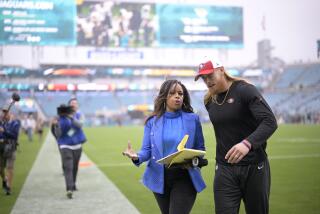Persistence Continues to Pay Off for Plumer in Long Run : Running: An auto accident nearly ended her career. Instead, she has become an elite competitor.
- Share via
PattiSue Plumer’s life flashed before her eyes as the car was bearing down on her.
“All I was thinking was, ‘I’m going to get hit by a car. I wonder what it’s going to feel like?’ ” Plumer recalled. “Everything went so slowly. I don’t have any memory of the pain.”
A world-class distance runner, Plumer sustained a broken left fibula in February, 1985, when she was struck by a taxi while crossing a busy intersection in Tokyo on her way to a training run in a park.
“The only thing that saved me was the fact that I jumped up,” Plumer said. “It’s sort of like the Randall Cunningham theory that if you’re going up you’re not going to get hurt.”
Plumer’s condition was diagnosed as a minor crack in her lower leg, and she was sent back to her hotel with crutches.
But the bone cracked completely as Plumer was stretching the next day, and she returned to Los Angeles, where doctors at the UCLA Medical Center told her she would be sidelined for a month.
Nine months later, Plumer was still unable to run because the injury hadn’t healed, and she decided to retire from track and enter the Stanford Law School. The relative inactivity helped the injury to heal.
After resuming her track career on the indoor circuit in the winter of 1986, Plumer went to Europe, where she had her best outdoor season.
Plumer continued to run after enrolling in law school, but a case of pneumonia the next year almost ended her career.
Hospitalized for two weeks, she was ready to abandon plans to compete in the 1988 Olympic trials.
But Plumer’s coach, Brooks Johnson, had other ideas.
Johnson visited Plumer in the Stanford Medical Center to outline his strategy for her comeback.
“I had an IV in one arm and I still had a temperature of 100,” Plumer said. “I was thinking that Brooks was out of his mind.”
But if Plumer could survive being hit by a car, Johnson believed she was strong enough to recover from pneumonia. After suffering a relapse in early 1988, Plumer resumed training April 15, three months before the Olympic trials.
“I was just going along with my coach’s fantasy,” Plumer said. “I didn’t think I had any chance of making the Olympic team. I hadn’t even qualified for the trials yet. I was going to take a certain amount of satisfaction in proving that my coach was finally wrong.”
But Plumer was wrong.
She earned a spot on the Olympic team by beating Sabrina Dornhoffer down the stretch to finish third in the 3,000 meters and grab the final position.
After running a personal best of 8:45.21 in a qualifying heat at the Seoul Games, Plumer thought she had a shot at winning a medal.
But Plumer developed food poisoning the day before the final and finished 13th with a time of 8:59.17.
After making the final, Plumer went to a hotel for dinner to celebrate. But she became ill after the meal and was too weak to race well.
Written off after the Olympics, Plumer emerged as one of the top female distance runners in the world in 1989.
“Most people thought my making the Olympic team was a fluke and that I’d probably never do anything else again,” Plumer said.
But she proved the doubters wrong.
After graduating from law school in June, 1989, Plumer’s career took off after she went to Europe, where she beat Paula Ivan of Romania, the Olympic 1,500 champion, in a 3,000 meet race at a Grand Prix meet in Lausanne, Switzerland, running a personal best of 8:42.12 to pass Ivan at the finish line.
“I certainly didn’t think I could beat her but with about 50 meters to go I just decided to go for it,” Plumer said. “I think she thought she had the race won and she’d started to deaccelerate. I passed her right at the tape and she couldn’t react.”
Ironically, Plumer had to beg the meet director to let her enter the race.
But Plumer doesn’t have to beg meet directors to let her enter races anymore. Al Franken, Sunkist meet promoter, paid Plumer an appearance fee in addition to her airline ticket and lodging to lure her to Friday’s meet at the Sports Arena.
“After (beating Ivan) I got into any race I wanted to,” Plumer said. “My appearance fees went up. It wasn’t like I was going to be rich, but I went from having to beg to get into races to having to choose between races.”
After beating Ivan, Plumer set an American record in the 5,000, breaking Mary Decker Slaney’s mark by more than six seconds with a time of 14:59.99
She continued to improve in 1990 winning the 3,000 meters at the Goodwill Games last August at Seattle and taking the 5,000 meters at the national championship meet, Plumer was ranked in the top four in the world in the 3,000 and 5,000 last year.
She also won the Fifth Avenue Mile last fall, running 4:16, the second-fastest time ever by a woman. However, the time won’t be considered for inclusion into the world list because it wasn’t run on a track.
A labor attorney employed by a large New York-based firm, Plumer, 28, has had to balance track with her career.
She has taken a leave of absence to compete on the indoor circuit this winter and prepare for the World Championships later this year.
“I’ve worked for the firm since I was in law school, but it’s been much harder since I became a lawyer,” Plumer said. “The workload increased and there was more stress.”
There was no stress on Plumer at the start of her college track career because she was a little-known high school runner from Montrose, Colo., who wasn’t good enough to earn an athletic scholarship to Stanford, where she was a walk-on.
That has all changed, and now the options are Plumer’s.
More to Read
Go beyond the scoreboard
Get the latest on L.A.'s teams in the daily Sports Report newsletter.
You may occasionally receive promotional content from the Los Angeles Times.







